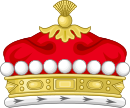| Viscountcy of Gormanston | |
|---|---|
  Or on a Chief Sable three Crescents of the First | |
| Creation date | 7 August 1478 |
| Created by | Edward IV |
| Peerage | Peerage of Ireland |
| First holder | Robert Preston, 4th Baron Gormanston |
| Present holder | Nicholas Preston, 17th Viscount Gormanston |
| Heir apparent | Hon. Jenico Preston |
| Subsidiary titles | Baron Gormanston (I) Baron Gormanston, of Whitewood (UK) |
| Status | Extant |
| Former seat(s) | Gormanston Castle |

Viscount Gormanston is a noble title, created in 1478, held by the Anglo-Irish Preston family since the Middle Ages. The oldest vicomital title in the British Isles, Lord Gormanston is accorded the style of Premier Viscount of Ireland. [1]
Contents
- Barons Gormanston (1365/1370)
- Viscounts Gormanston (1478)
- See also
- References
- External links
- Further reading
Descended from Sir Robert Preston, who served as Lord Chancellor of Ireland, sometime between 1365 and 1370, he was created Baron Gormanston by writ of the Parliament of Ireland. His son and heir, Sir Christopher Preston [2] the second Baron, played a prominent part in public affairs, and was arrested for treason in 1418. His great-grandson, Sir Robert Preston the fourth Baron, served as Lord Deputy of Ireland: in 1478 he was created Viscount Gormanston in the peerage of Ireland. His son, Sir William Preston the second Viscount, served as Lord Justice of Ireland in 1525. A later descendant, the seventh Viscount, was a supporter of King James II and was outlawed after the Glorious Revolution.
Jenico Preston helped to suppress the Irish Rebellion of 1798, [3] and in 1800 he had the outlawry reversed and was summoned to the Irish House of Lords as the twelfth Viscount Gormanston. He was the great-grandson of Anthony Preston, the de jure ninth Viscount Gormanston, the nephew of the seventh Viscount. The twelfth Viscount was succeeded by his son, the thirteenth Viscount. In 1868 he was created Baron Gormanston, of Whitewood in County Meath, in the peerage of the United Kingdom, [4] which gave the Viscounts an automatic seat in the House of Lords. [5] His son, the fourteenth Viscount, notably served as Governor of British Guiana and as Governor of Tasmania. The 15th Viscount was a Captain in the Royal Irish Fusiliers and a Deputy Lieutenant for County Meath. [6] As of 2025 [update] the peerage titles are held by the latter's great-grandson who succeeded as the seventeenth Viscount in 1940 at the age of seven months, when his father was killed in action during the Battle of France during the Second World War.
Another member of the Preston family was Thomas Preston, 1st Viscount Tara. He was the second son of the fourth Viscount Gormanston. Also, John Preston, 1st Baron Tara, was a descendant of a younger brother.
The unusual first name Jenico borne by many of Preston family sons derives from the Gascon-born soldier Sir Jenico d'Artois, a prominent military commander who became a substantial landowner in Ireland. His daughter and heiress Jeanne married the 3rd Baron Gormanston, being the mother of Sir Robert Preston, later created a viscount.
The ancestral seat was Gormanston Castle, County Meath, close to the county border with Dublin.
